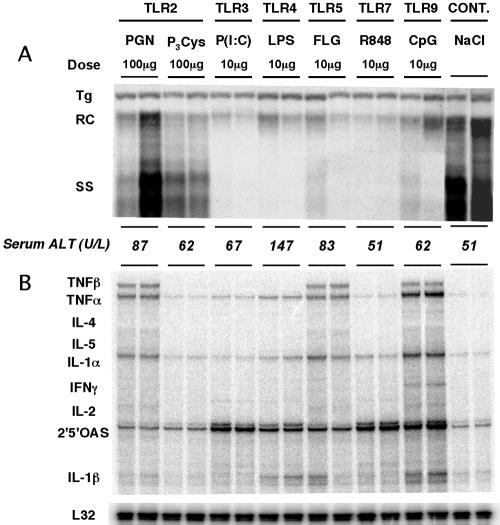FIG. 1.
Toll-like receptor ligands inhibit HBV replication in vivo. Age-, sex-, and serum HBeAg-matched lineage 1.3.32 HBV transgenic mice were injected intravenously with 20 μg (not shown) and 100 μg of TLR2/6 (peptidoglycan [PGN] from Staphylococcus aureus; InvivoGen), TLR2/1 ligand N-α-palmitoyl-S-[2,3-bis(palmitoyloxy)-(2RS)-propyl]-l-cysteine (Pam3Cys; InvivoGen), 10 μg of TLR3 [polyinosinic-poly(I · C); P(I:C); Sigma]) TLR4 (LPS from Escherichia coli 011:B4 strain; InvivoGen), TLR5 (Flagellin from salmonella muenchen; Calbiochem), TLR7 (R848) (InvivoGen), or TLR9 (ODN 1826 CpG oligonucleotide [CpG]; InvivoGen) ligands and sacrificed 24 h later. Lineage 1.3.32 mice replicate HBV at high levels in the liver without any evidence of cytopathology (9). (A) Total hepatic DNA was isolated from frozen liver tissues and analyzed for HBV DNA by Southern blot analysis as previously described (9). Bands corresponding to the integrated transgene (Tg), relaxed circular double stranded (RC), and single-stranded (SS) HBV DNA replicative forms are indicated. The integrated transgene can be used to normalize the amount of DNA bound to the membrane. The mean serum ALT activity, measured at the time of autopsy, is indicated for each group and is expressed in units/liter. (B) Total hepatic RNA was also isolated from the same mice and analyzed by RNase protection assay for the expression of various cytokines as previously described (8). The RNA encoding the ribosomal protein L32 was used to normalize the amount of RNA loaded in each lane.

